@Drewgong you wont regret buying the O2 kit. As @MHB said (in more detail than I have the patience to write out for someone else), O2 is critical at the start of the fermentation process.
Going back to your original post, if you're getting diacetyl off flavours in your beers, the most likely culprit is too short a diacetyl rest. Make sure that when fermentation is almost finished, you ramp the temperature right up to the top of the healthy range for the yeast variety you're using and give it at least 24 hours at that temperature. That rest before cold crashing will do wonders for scrubbing off some of the byproducts that yeast leave behind during their most active phase, including diacetyl. It's also worth doing a forced fermentation test to check the diacetyl has been scrubbed before you begin your cold crash. It is a little bit of extra work, but worth it in terms of ensuring your beer is going to be optimum quality.
Going back to your original post, if you're getting diacetyl off flavours in your beers, the most likely culprit is too short a diacetyl rest. Make sure that when fermentation is almost finished, you ramp the temperature right up to the top of the healthy range for the yeast variety you're using and give it at least 24 hours at that temperature. That rest before cold crashing will do wonders for scrubbing off some of the byproducts that yeast leave behind during their most active phase, including diacetyl. It's also worth doing a forced fermentation test to check the diacetyl has been scrubbed before you begin your cold crash. It is a little bit of extra work, but worth it in terms of ensuring your beer is going to be optimum quality.





